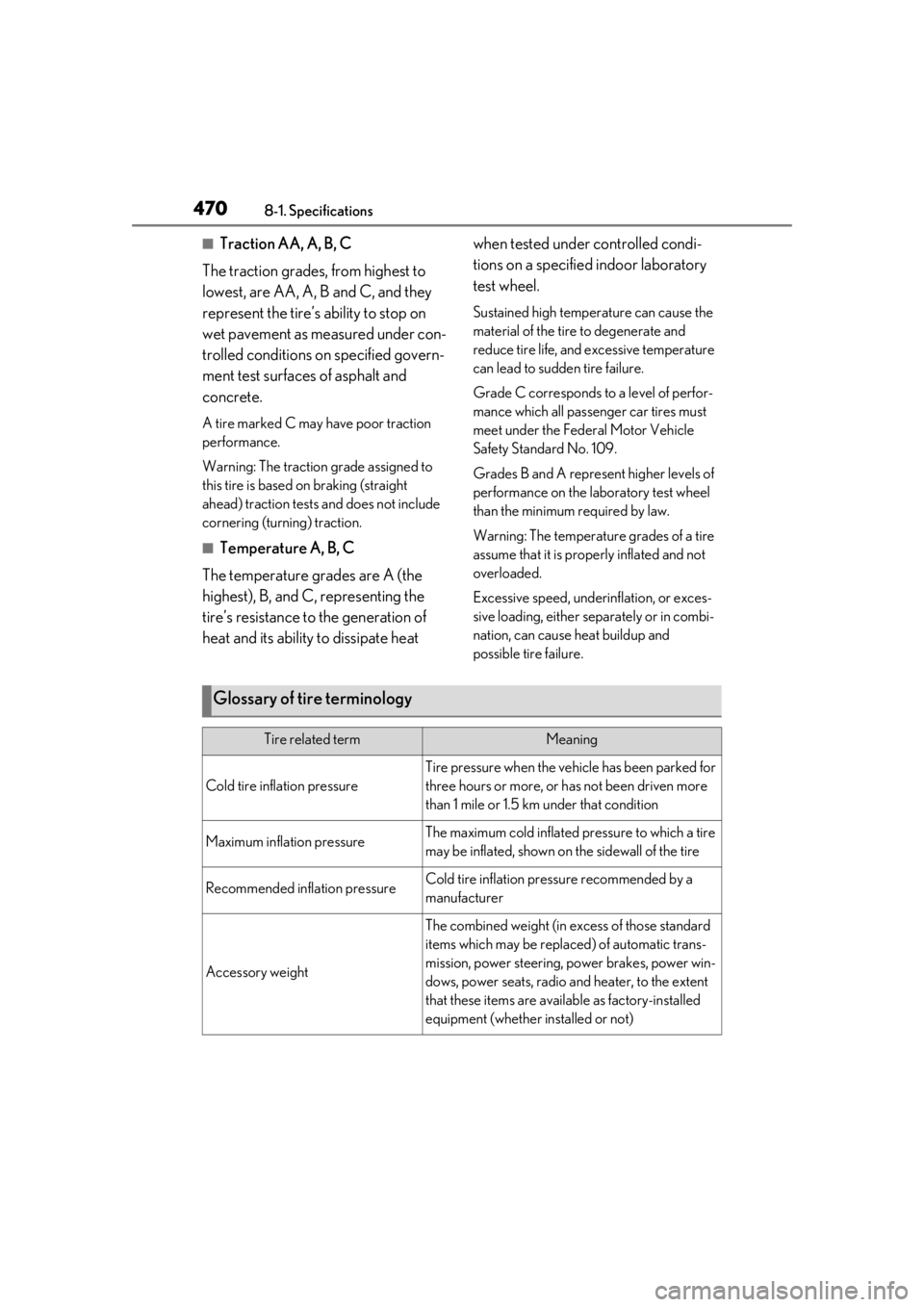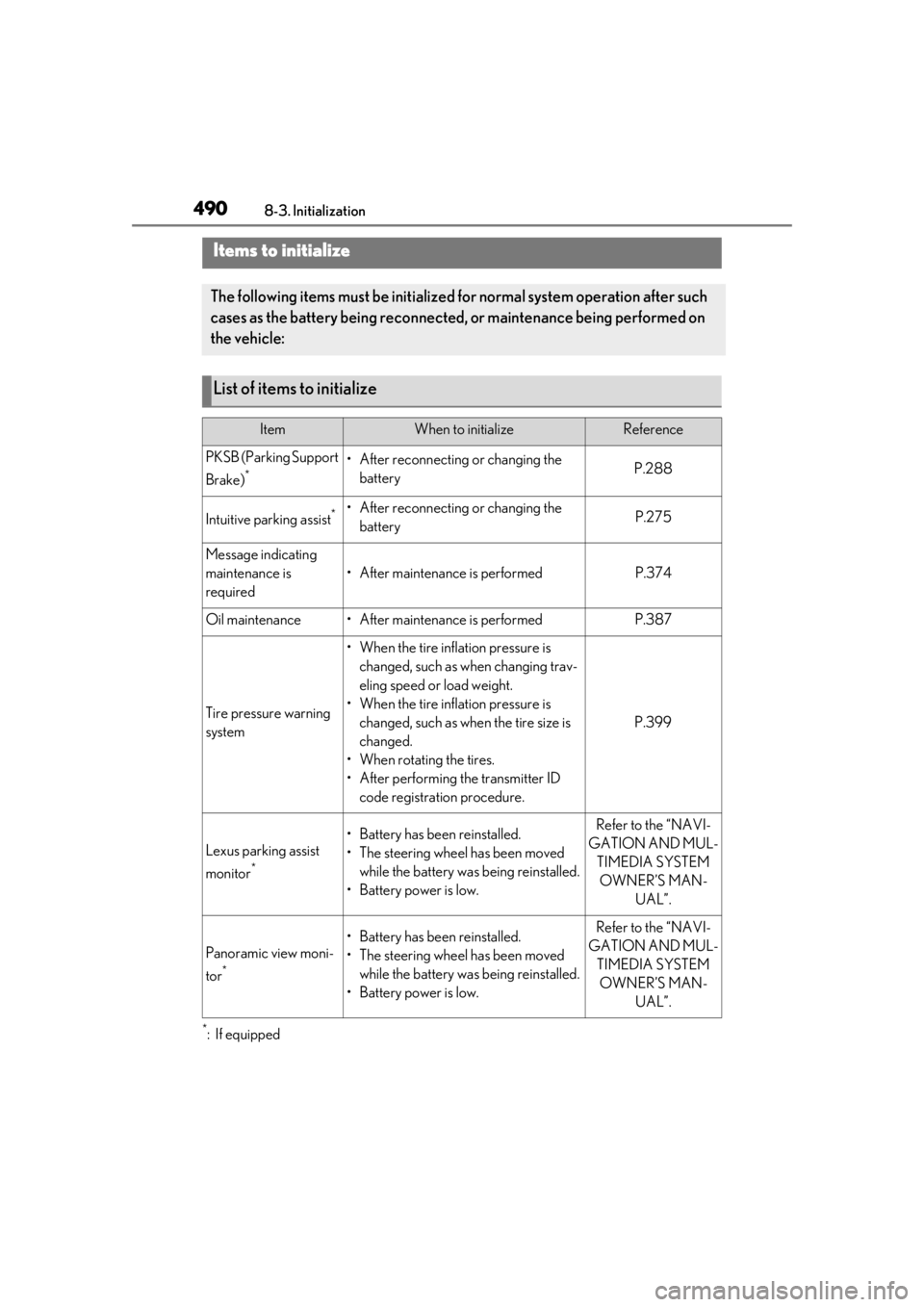Page 470 of 520

4708-1. Specifications
■Traction AA, A, B, C
The traction grades, from highest to
lowest, are AA, A, B and C, and they
represent the tire’s ability to stop on
wet pavement as measured under con-
trolled conditions on specified govern-
ment test surfaces of asphalt and
concrete.
A tire marked C may have poor traction
performance.
Warning: The traction grade assigned to
this tire is based on braking (straight
ahead) traction tests and does not include
cornering (turning) traction.
■Temperature A, B, C
The temperature grades are A (the
highest), B, and C, representing the
tire’s resistance to the generation of
heat and its ability to dissipate heat when tested under controlled condi-
tions on a specified indoor laboratory
test wheel.
Sustained high temperature can cause the
material of the tire to degenerate and
reduce tire life, and excessive temperature
can lead to sudd
en tire failure.
Grade C corresponds to a level of perfor-
mance which all passenger car tires must
meet under the Fede ral Motor Vehicle
Safety Standard No. 109.
Grades B and A represent higher levels of
performance on the laboratory test wheel
than the minimum required by law.
Warning: The temperature grades of a tire
assume that it is properly inflated and not
overloaded.
Excessive speed, unde rinflation, or exces-
sive loading, either separately or in combi-
nation, can cause heat buildup and
possible tire failure.
Glossary of tire terminology
Tire related termMeaning
Cold tire inflation pressure
Tire pressure when the vehicle has been parked for
three hours or more, or has not been driven more
than 1 mile or 1.5 km under that condition
Maximum inflation pressureThe maximum cold inflated pressure to which a tire
may be inflated, shown on the sidewall of the tire
Recommended inflation pressureCold tire inflation pressure recommended by a
manufacturer
Accessory weight
The combined weight (in excess of those standard
items which may be replaced) of automatic trans-
mission, power steering, power brakes, power win-
dows, power seats, radio and heater, to the extent
that these items are available as factory-installed
equipment (whether installed or not)
Page 471 of 520

4718-1. Specifications
8
Vehicle specifications
Curb weight
The weight of a motor vehicle with standard equip-
ment, including the maximum capacity of fuel, oil
and coolant, and if so equipped, air conditioning
and additional weight optional engine
Maximum loaded vehicle weight
The sum of:
(a) Curb weight
(b) Accessory weight
(c) Vehicle capacity weight
(d) Production options weight
Normal occupant weight
150 lb. (68 kg) times the number of occupants
specified in the second column of Table 1
* that fol-
lows
Occupant distributionDistribution of occupants in a vehicle as specified in
the third column of Table 1
* below
Production options weight
The combined weight of installed regular produc-
tion options weighing over 5 lb. (2.3 kg) in excess of
the standard items which they replace, not previ-
ously considered in curb weight or accessory
weight, including heavy duty brakes, ride levelers,
roof rack, heavy duty battery, and special trim
RimA metal support for a tire or a tire and tube assem-
bly upon which the tire beads are seated
Rim diameter (Wheel diameter)Nominal diameter of the bead seat
Rim size designationRim diameter and width
Rim type designationThe industry manufacturer’s designation for a rim
by style or code
Rim widthNominal distance between rim flanges
Vehicle capacity weight (Total load
capacity)The rated cargo and luggage load plus 150 lb. (68
kg) times the vehicle’s designated seating capacity
Vehicle maximum load on the tire
The load on an individual ti re that is determined by
distributing to each axle its share of the maximum
loaded vehicle weight, and dividing by two
Tire related termMeaning
Page 474 of 520

4748-1. Specifications
Pneumatic tire
A mechanical device made of rubber, chemicals,
fabric and steel or other materials, that, when
mounted on an automotive wheel, provides the
traction and contains the gas or fluid that sustains
the load
Radial ply tire
A pneumatic tire in which the ply cords that extend
to the beads are laid at substantially 90 degrees to
the centerline of the tread
Reinforced tire
A tire designed to operat e at higher loads and at
higher inflation pressures than the corresponding
standard tire
Section width
The linear distance between the exteriors of the
sidewalls of an inflated tire, excluding elevations
due to labeling, decoration, or protective bands
SidewallThat portion of a tire between the tread and bead
Sidewall separationThe parting of the rubber compound from the cord
material in the sidewall
Snow tire
A tire that attains a traction index equal to or
greater than 110, compared to the ASTM E-1136
Standard Referenc e Test Tire, when using the snow
traction test as described in ASTM F-1805-00,
Standard Test Method fo r Single Wheel Driving
Traction in a Straight Line on Snow-and Ice-Cov-
ered Surfaces, and which is marked with an Alpine
Symbol ( ) on at least one sidewall
Test rimThe rim on which a tire is fitted for testing, and may
be any rim listed as appropriate for use with that tire
TreadThat portion of a tire that comes into contact with
the road
Tread ribA tread section running ci rcumferentially around a
tire
Tread separationPulling away of the tread from the tire carcass
Tire related termMeaning
Page 475 of 520
4758-1. Specifications
8
Vehicle specifications
*: Table 1 -Occupant loading and distribution for vehicle normal load for various desig-nated seating capacities
Treadwear indicators (TWI)
The projections within the principal grooves
designed to give a visual indication of the degrees
of wear of the tread
Wheel-holding fixtureThe fixture used to hold the wheel and tire assembly
securely during testing
Tire related termMeaning
Designated seating capac- ity, Number of occupantsVehicle normal load, Num- ber of occupantsOccupant distribution in a normally loaded vehicle
2 through 422 in front
5 through 1032 in front, 1 in second seat
11 through 1552 in front, 1 in second seat, 1 in third seat, 1 in fourth seat
16 through 2072 in front, 2 in second seat, 2 in third seat, 1 in fourth seat
Page 482 of 520
4828-2. Customization
*:If equipped
■Driving position memory (P.133)
■Outside rear view mirrors ( P.151)
Door linked rear seat with
ottoman seatback position for
exiting
*
More upright
than upright posi- tion
Upright position——O—
Shift-linked rear seat reclining
functionOnOff———O
FunctionDefault settingCustomized set-ting
Selecting doors linked to the
memory recall functionDriver’s doorAll doors———O
Driver’s seat slide movement
when exiting the vehicleFullOffO——OPartial
Driver’s seat height move-
ment when exiting the vehicleOffFullO——OPartial
Steering wheel movementTilt only
Off
O——OTelescopic only
Tilt and telescopic
FunctionDefault settingCustomized set-ting
Automatic mirror folding and
extending operationLinked to the
locking/ unlock- ing of the doorsOff
———OLinked to opera-
tion of the engine switch
FunctionDefault settingCustomized set- tingABCD
ABCD
ABCD
Page 484 of 520
4848-2. Customization
*:Except for Canada
■PCS (Pre-Collision System) (P.215, 227)
*:If equipped
■FCTA (Front Cross Traffic Alert)* ( P.236)
*:If equipped
■LTA (Lane Tracing Assist) ( P.238)
*: Vehicles with Lexus Safety System + A
FunctionDefault settingCustomized set-
ting
PCS (Pre-Collision System)OnOff—O——
Adjust alert timingMiddleEarly—O——Late
Pedestrian alert*OnOff—O——
FunctionDefault settingCustomized set-ting
FCTA functionOnOff—O——
Adjust alert timingMiddleEarly—O——Late
FunctionDefault settingCustomized set-ting
Lane centering functionOnOff—O——
Steering assist functionOnOff—O——
Lane change assist function*OnOff—O——
Alert typeSteering wheel vibrationBuzzer—O——
Alert sensitivityHighStandard—O——
Vehicle sway warning func-
tionOnOff—O——
Vehicle sway warning sensi-
tivityStandardHigh—O——Low
ABCD
ABCD
ABCD
Page 488 of 520
4888-2. Customization
*1: If equipped
*2: Vehicles without power rear seat
■Heated steering wheel* ( P.336)
*:If equipped
■Illumination ( P.340)
Left-hand rear seat tempera-
ture preference in automatic
mode
*1Standard-2 (cooler) to 2
(warmer)O——O
Right-hand rear seat tem-
perature preference in auto-
matic mode
*1Standard-2 (cooler) to 2 (warmer)O——O
Engine switch linked auto-
matic activation of the
left-hand rear seat heater
*2OffOnO——O
Engine switch linked auto-
matic activation of the
right-hand rear seat heater
*2OffOnO——O
FunctionDefault settingCustomized set- ting
Steering wheel heating pref-
erence in automatic modeStandard-2 (low) to 2 (high)O——O
FunctionDefault settingCustomized set- ting
Time elapsed before the inte-
rior lights turn off15 seconds
Off
O——O7.5 seconds
30 seconds
Operation after the engine
switch is turned offOnOff———O
Operation when the doors
are unlockedOnOff———O
FunctionDefault settingCustomized set-tingABCD
ABCD
ABCD
Page 490 of 520

4908-3. Initialization
8-3.Initialization
*:If equipped
Items to initialize
The following items must be initialized for normal system operation after such
cases as the battery being reconnected, or maintenance being performed on
the vehicle:
List of items to initialize
ItemWhen to initializeReference
PKSB (Parking Support
Brake)
*• After reconnecting or changing the batteryP.288
Intuitive parking assist*• After reconnecting or changing the batteryP.275
Message indicating
maintenance is
required
• After maintenance is performedP.374
Oil maintenance• After maintenance is performedP.387
Tire pressure warning
system
• When the tire inflation pressure is changed, such as when changing trav-
eling speed or load weight.
• When the tire inflation pressure is changed, such as when the tire size is
changed.
• When rotating the tires.
• After performing the transmitter ID code registration procedure.
P.399
Lexus parking assist
monitor
*
• Battery has been reinstalled.
• The steering wheel has been moved while the battery was being reinstalled.
• Battery power is low.Refer to the “NAVI-
GATION AND MUL- TIMEDIA SYSTEM OWNER’S MAN- UAL”.
Panoramic view moni-
tor
*
• Battery has been reinstalled.
• The steering wheel has been moved while the battery was being reinstalled.
• Battery power is low.Refer to the “NAVI-
GATION AND MUL- TIMEDIA SYSTEM OWNER’S MAN- UAL”.